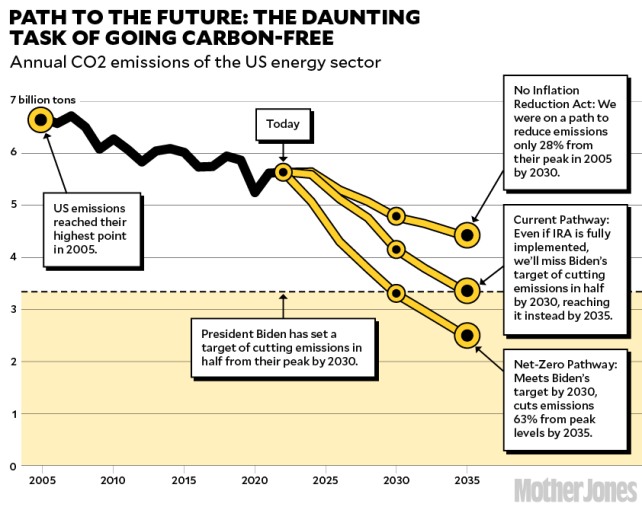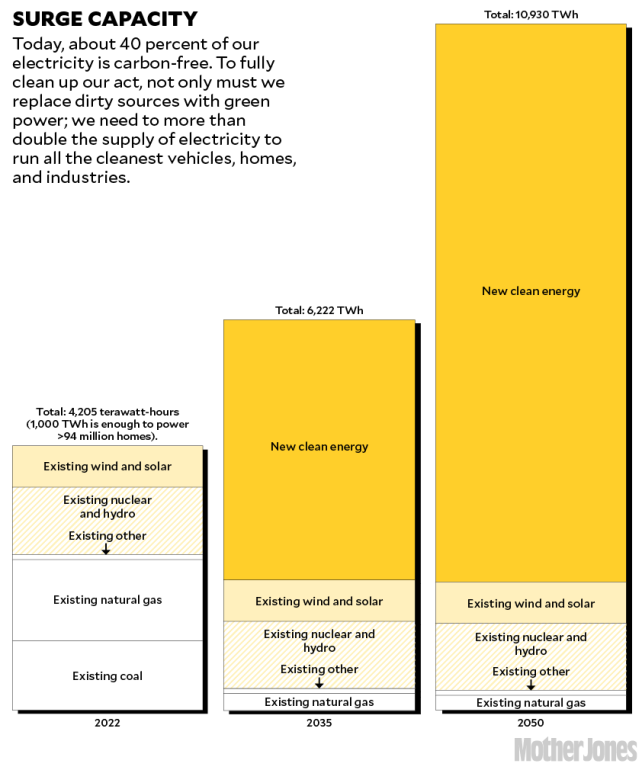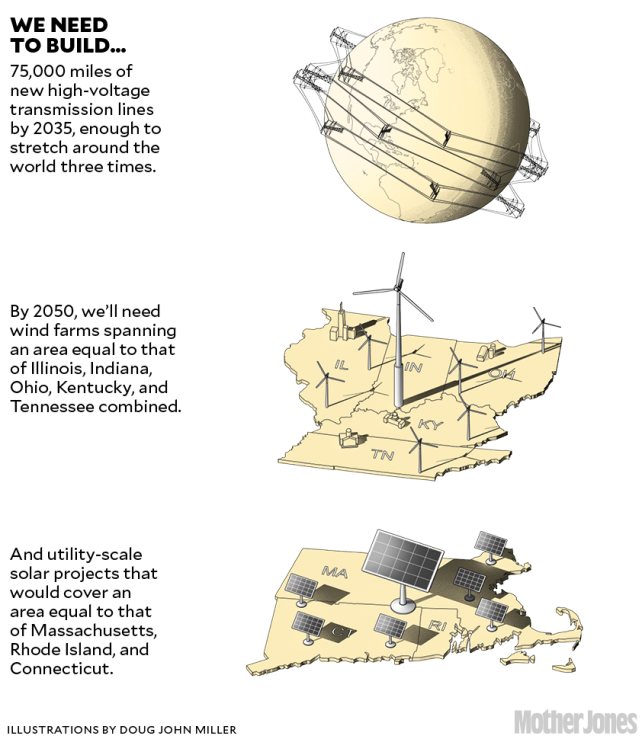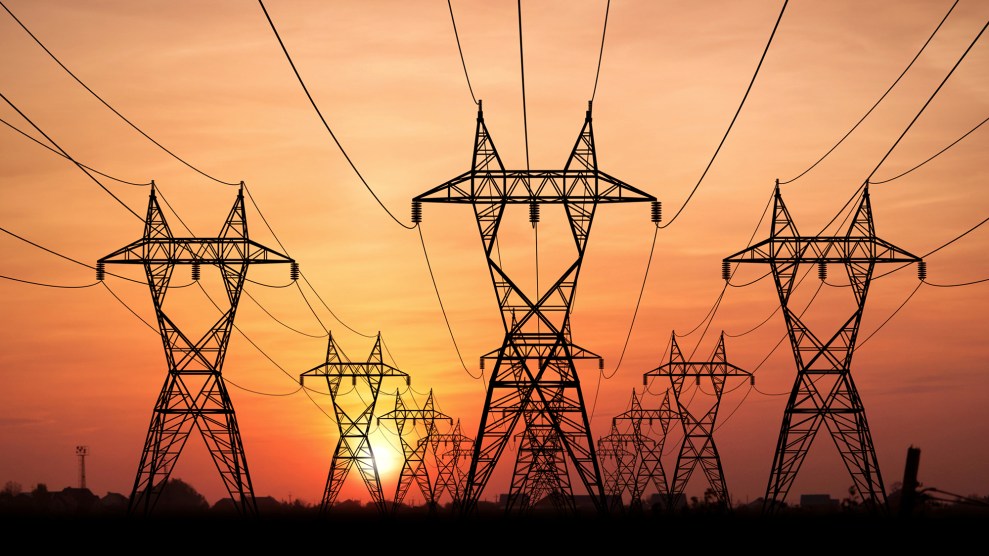The United States is on the brink of its most consequential transformation since the New Deal. Read more about what it takes to decarbonize the economy, and what stands in the way, here.
For the first time in history, the full financial weight of the United States federal government is aligned behind an epic transition to clean energy. A trio of energy, infrastructure, and science laws passed by the last Congress will deploy more than half a trillion dollars of public funding over the next decade to wean us off fossil fuels and make greener alternatives cheap and ubiquitous.
Uncle Sam will pick up a huge chunk of the tab for energy sources like wind and solar, and cleaner consumer choices like electric vehicles and heat pumps. Thanks to these new laws, which will also unlock hundreds of billions in private investment in clean energy, it’ll simply be the smarter financial decision to choose clean over dirty in the countless decisions made by millions of households and businesses. With the thumb firmly on the clean side of the scale, the fight against climate change in America has fundamentally changed.
And yet the work is just getting started.
I’m a macro-energy systems engineering expert. I’ve spent the past four years at Princeton leading research teams that have carefully modeled pathways for America to reach net-zero greenhouse gas emissions and analyzed the impacts of proposed and enacted federal climate and energy policy. According to our research, these three laws could roughly double our current pace of decarbonization, leading to an average 4 percent drop in emissions each year through 2030, reducing total emissions to roughly 40 percent of their peak, and to levels not seen since 1967.
That’s historic progress. But it still falls short of the goal of 50 percent below peak emissions that President Joe Biden has pledged—a benchmark consistent with the global mission of limiting warming to less than 2 degrees Celsius and with putting the United States on track to reach net-zero emissions by 2050. Hitting those more ambitious but urgently needed targets will require we move faster still, slashing emissions by about 6 percent per year through 2030.
That’s a lot of numbers, and what they obscure is the sheer physical scale of the national project America must now commit to. To get on the path to net-zero, we must rebuild most of the physical energy infrastructure of this country. And we need to do it with unprecedented speed.

Take the electricity grid, the linchpin in our efforts to decarbonize America. Electricity is an extremely versatile way to move energy around our economy and put it to work. If we can make that electricity in a clean way, we’ve got a soup-to-nuts pathway for carbon-free energy production, transport, and use.
Today, about 40 percent of our electricity comes from carbon-free sources—about 25 percent from nuclear and hydropower plants and 14 percent from rapidly expanding wind and solar power. (New options like advanced geothermal and nuclear, carbon capture and storage, clean hydrogen, and cheap, large-scale energy storage are all being brought to market, but none are yet significant.) Generating electricity is our second-largest source of greenhouse gas emissions (after vehicles), producing about a quarter of US climate-warming pollution.
The challenge, then, is twofold. First, we must grow that share of carbon-free electricity from 40 percent to 100 percent as fast as we possibly can—and do so even as we dramatically expand our electricity supply, which must more than double by 2050 to accommodate all the new EVs and heat pumps, electrify industrial processes, and so forth. To meet those twin challenges, we’ll have to build as much new clean generation by 2035 as the total electricity produced by all sources today, then build that same amount again by 2050. This could ultimately require utility-scale solar projects that cover an area the size of Massachusetts, Rhode Island, and Connecticut combined, and wind farms that span an area equal to that of Illinois, Indiana, Ohio, Kentucky, and Tennessee. (Because turbines need to be spaced out, the actual equipment of wind farms would physically occupy only 1 per- cent of the area needed.)
In short, it took us about 150 years from the days of Edison, Tesla, and Westinghouse to build today’s grid. Now we have to double the grid’s electricity generation, using only new, clean resources, in just three decades.
The immediate challenge is to smash record rates of wind and solar expansion. Through the end of 2030, we’ll need to double our fastest pace of adding renewables—and then accelerate to 3.5 times that rate by 2035.

Daunting. The good news is that, according to the US Energy Information Administration, we’re on track for solar. The bad news is that—due to supply chain issues, long wait times to connect to the grid, and the anemic rate of long-distance transmission buildout—the wind sector is falling behind; in 2023 and 2024, the EIA expects we’ll add just half as much wind capacity as we did at our peak rate. We’ve got to accelerate, or we’ll fall far short of the nation’s clean energy goals.
Building new wind and solar at this clip also means building new power lines more than twice as fast as we have over the past decade. If we’re going to plug in millions of new electric vehicles and heat pumps and tap into the best areas to generate wind and solar power, we’re simply going to need a bigger grid—up to 75,000 miles of new high-voltage lines by 2035, enough to run the distance from Los Angeles to New York City and back 15 times, or circle the Earth three times.
It’s not impossible. From the 1970s through the 1990s, as electricity demand grew steadily, we built new transmission capacity at nearly the pace required now. If we can do that again, we unlock a massive backlog of some 1,280,000 megawatts of green energy projects stuck waiting for grid connections. If only half of those projects get completed, it would be all the new capacity we need to have by 2030. The price of failure, meanwhile, is harrowing. If we can’t expand the transmission grid that fast, we could lose as much as 80 percent of the emissions reductions that the three laws could deliver, as soaring demand from EVs and other electrification is met by natural gas and coal-fired power plants instead of new renewables.
Of course, a new grid is just one piece of the larger puzzle. We have to build new factories to produce electric vehicles, batteries, wind turbines, solar panels, and their components. We need new industrial clusters to harness clean hydrogen and capture carbon dioxide emissions and new pipelines to safely transport both gases. We need charging networks for both personal vehicles and heavy-duty electric trucks and buses. And much more.
In short, we need to build, build, build.

For my entire lifetime, we’ve been coasting off infrastructure investments made between the New Deal and the 1970s, be it the rural electrification and hydropower dams of the 1930s, or the Eisenhower interstate highway system, or the nation’s aging fleet of nuclear power plants and transportation hubs. Most people alive today haven’t experienced the kind of building boom we must embark upon.
Rather than tack the cost of these enormous public works projects onto Americans’ energy bills, our lawmakers wielded the much more progressive federal tax code. In particular, the Inflation Reduction Act is funded by a new minimum tax on billion-dollar corporations, a new tax on corporate stock buybacks, and expanded IRS enforcement to make the uberwealthy pay what they owe. Taxing big corporations and cracking down on tax cheats to pay for cleaner, cheaper energy for all Americans: That’s a pretty good deal. Even better, ditching fossil fuels will bring about one of the biggest improvements in public health in generations, preventing roughly 35,000 premature deaths over the next decade alone.
We now have the potential to rebuild a better America. The incentives are already working. Every week, it seems, I read about billions of dollars being invested in a new EV or battery or solar manufacturing facility, each bringing thousands of new jobs to communities across America. As of this writing, more than 80 projects—totaling $200 billion in investment and 70,000 jobs—have been announced. We could see nearly a million new jobs in solar and wind manufacturing by 2030, another 800,000 installing wind and solar projects and building out the grid, and hundreds of thousands more in the electrifying automotive sector.
But to fully secure the promise of these three laws, we must overcome obstacles at all levels, from securing local support for new projects and training the workforce to build them to revamping federal and state permitting to simultaneously move faster and ensure affected communities are heard. This will not be easy. Few today remember the hassle of living through the construction of the New Deal—and none of us should forget how past highway construction and “urban renewal” projects devastated poor communities. But we must also quell counterproductive nimby impulses and keep focused on the greater project at hand.
Building the new infrastructure for a cleaner, healthier, more prosperous America that can meet our climate commitments is within reach. It is time to roll up our sleeves and build that future.
















